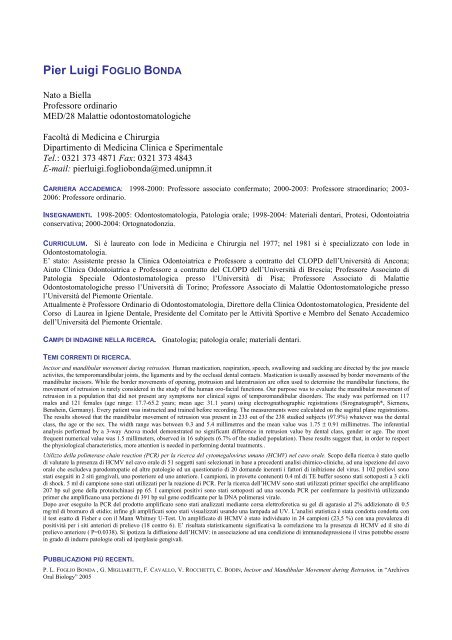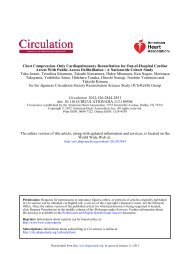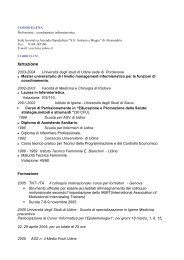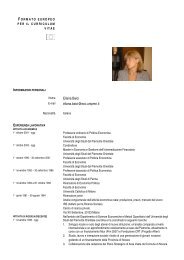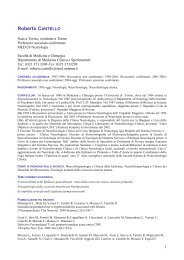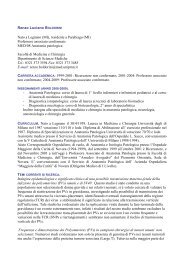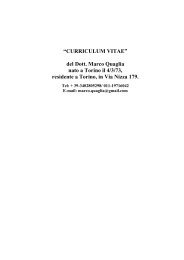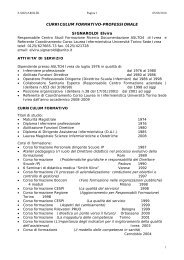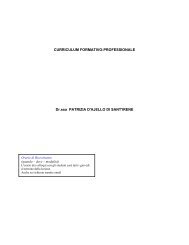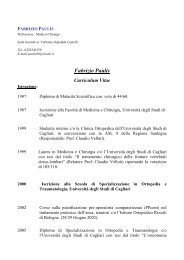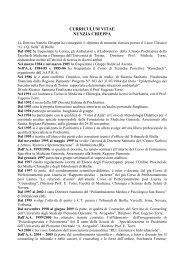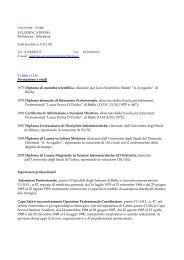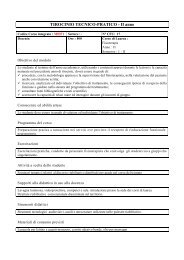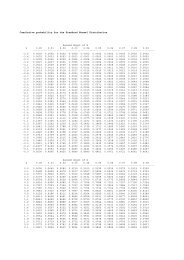Foglio Bonda Pier Luigi.pdf - Università del Piemonte Orientale
Foglio Bonda Pier Luigi.pdf - Università del Piemonte Orientale
Foglio Bonda Pier Luigi.pdf - Università del Piemonte Orientale
You also want an ePaper? Increase the reach of your titles
YUMPU automatically turns print PDFs into web optimized ePapers that Google loves.
<strong>Pier</strong> <strong>Luigi</strong> FOGLIO BONDA<br />
Nato a Biella<br />
Professore ordinario<br />
MED/28 Malattie odontostomatologiche<br />
Facoltà di Medicina e Chirurgia<br />
Dipartimento di Medicina Clinica e Sperimentale<br />
Tel.: 0321 373 4871 Fax: 0321 373 4843<br />
E-mail: pierluigi.fogliobonda@med.unipmn.it<br />
CARRIERA ACCADEMICA: 1998-2000: Professore associato confermato; 2000-2003: Professore straordinario; 2003-<br />
2006: Professore ordinario.<br />
INSEGNAMENTI. 1998-2005: Odontostomatologia, Patologia orale; 1998-2004: Materiali dentari, Protesi, Odontoiatria<br />
conservativa; 2000-2004: Ortognatodonzia.<br />
CURRICULUM. Si è laureato con lode in Medicina e Chirurgia nel 1977; nel 1981 si è specializzato con lode in<br />
Odontostomatologia.<br />
E’ stato: Assistente presso la Clinica Odontoiatrica e Professore a contratto <strong>del</strong> CLOPD <strong>del</strong>l’<strong>Università</strong> di Ancona;<br />
Aiuto Clinica Odontoiatrica e Professore a contratto <strong>del</strong> CLOPD <strong>del</strong>l’<strong>Università</strong> di Brescia; Professore Associato di<br />
Patologia Speciale Odontostomatologica presso l’<strong>Università</strong> di Pisa; Professore Associato di Malattie<br />
Odontostomatologiche presso l’<strong>Università</strong> di Torino; Professore Associato di Malattie Odontostomatologiche presso<br />
l’<strong>Università</strong> <strong>del</strong> <strong>Piemonte</strong> <strong>Orientale</strong>.<br />
Attualmente è Professore Ordinario di Odontostomatologia, Direttore <strong>del</strong>la Clinica Odontostomatologica, Presidente <strong>del</strong><br />
Corso di Laurea in Igiene Dentale, Presidente <strong>del</strong> Comitato per le Attività Sportive e Membro <strong>del</strong> Senato Accademico<br />
<strong>del</strong>l’<strong>Università</strong> <strong>del</strong> <strong>Piemonte</strong> <strong>Orientale</strong>.<br />
CAMPI DI INDAGINE NELLA RICERCA. Gnatologia; patologia orale; materiali dentari.<br />
TEMI CORRENTI DI RICERCA.<br />
Incisor and mandibular movement during retrusion. Human mastication, respiration, speech, swallowing and suckling are directed by the jaw muscle<br />
activites, the temporomandibular joints, the ligaments and by the occlusal dental contacts. Mastication is usually assessed by border movements of the<br />
mandibular incisors. While the border movements of opening, protrusion and lateratrusion are often used to determine the mandibular functions, the<br />
movement of retrusion is rarely considered in the study of the human oro-facial functions. Our purpose was to evaluate the mandibular movement of<br />
retrusion in a population that did not present any symptoms nor clinical signs of temporomandibular disorders. The study was performed on 117<br />
males and 121 females (age range: 17.7-65.2 years; mean age: 31.1 years) using electrognathographic registrations (Sirognatograph*, Siemens,<br />
Benshein, Germany). Every patient was instructed and trained before recording. The measurements were calculated on the sagittal plane registrations.<br />
The results showed that the mandibular movement of retrusion was present in 233 out of the 238 studied subjects (97.9%) whatever was the dental<br />
class, the age or the sex. The width range was between 0.3 and 5.4 millimetres and the mean value was 1.75 ± 0.91 millimetres. The inferential<br />
analysis performed by a 3-way Anova mo<strong>del</strong> demonstrated no significant difference in retrusion value by dental class, gender or age. The most<br />
frequent numerical value was 1.5 millimeters, observed in 16 subjects (6.7% of the studied population). These results suggest that, in order to respect<br />
the physiological characteristics, more attention is needed in performing dental treatments..<br />
Utilizzo <strong>del</strong>la polimerase chain reaction (PCR) per la ricerca <strong>del</strong> cytomegalovirus umano (HCMV) nel cavo orale. Scopo <strong>del</strong>la ricerca è stato quello<br />
di valutare la presenza di HCMV nel cavo orale di 51 soggetti sani selezionati in base a precedenti analisi chimico-cliniche, ad una ispezione <strong>del</strong> cavo<br />
orale che escludeva parodontopatie ed altre patologie ed un questionario di 20 domande inerenti i fattori di inibizione <strong>del</strong> virus. I 102 prelievi sono<br />
stati eseguiti in 2 siti gengivali, uno posteriore ed uno anteriore. I campioni, in provette contenenti 0.4 ml di TE buffer sosono stati sottoposti a 3 cicli<br />
di shock. 5 ml di campione sono stati utilizzati per la reazione di PCR. Per la ricerca <strong>del</strong>l’HCMV sono stati utilizzati primer specifici che amplificano<br />
207 bp sul gene <strong>del</strong>la proteinchinasi pp 65. I campioni positivi sono stati sottoposti ad una seconda PCR per confermare la positività utilizzando<br />
primer che amplificano una porzione di 391 bp sul gene codificante per la DNA polimerasi virale.<br />
Dopo aver eseguito la PCR <strong>del</strong> prodotto amplificato sono stati analizzati mediante corsa elettroforetica su gel di agarasio al 2% addizionato di 0.5<br />
mg/ml di bromuro di etidio; infine gli amplificati sono stati visualizzati usando una lampada ad UV. L’analisi statistica è stata condotta condotta con<br />
il test esatto di Fisher e con il Mann Whitney U-Test. Un amplificato di HCMV è stato individuato in 24 campioni (23,5 %) con una prevalenza di<br />
positività per i siti anteriori di prelievo (18 contro 6). E’ risultata statisticamente significativa la correlazione tra la presenza di HCMV ed il sito di<br />
prelievo anteriore ( P=0.0338). Si ipotizza la diffusione <strong>del</strong>l’HCMV: in associazione ad una condizione di immunodepressione il virus potrebbe essere<br />
in grado di indurre patologie orali ed iperplasie gengivali.<br />
PUBBLICAZIONI PIÙ RECENTI.<br />
P. L. FOGLIO BONDA , G. MIGLIARETTI, F. CAVALLO, V. ROCCHETTI, C. BODIN, Incisor and Mandibular Movement during Retrusion, in “Archives<br />
Oral Biology” 2005
C. MORTELLARO, U. GARAGIOLA, V. CARBONE, F. CERUTTI, V. MARCI, P. L. FOGLIO BONDA, Unusual Oral Manifestations and Evolution in<br />
Glycogen Storage Disease Type 1b, in “Journal of Craniofacial Surgery” 2005<br />
P. L. FOGLIO BONDA, M. GARIGLIO, M. DE ANDREA, D. MANNELLA, S. VERHOVEZ, Utilizzo <strong>del</strong>la polimerase chain reaction (PCR) per la ricerca <strong>del</strong><br />
cytomegalovirus umano (HCMV) nel cavo orale di 51 soggetti sani, in “Rivista Italiana di Igiene Dentale” 2005<br />
C. BODIN, P. L. FOGLIO BONDA, J. ABJEAN, Restauration fonctionelle par ajustement occlusal, in “Enciclopédie Medico-Chirurgicale Odontologie”<br />
2004<br />
C. BODIN, D. PAGANI, P. L. FOGLIO BONDA, Studio clinico e radiologico <strong>del</strong>l’osteonecrosi temporomandibolare, in “Doctor Os” 2003<br />
P. L. FOGLIO BONDA, C. BODIN, Disordini intrarticolari: valutazione mediante risonanza magnetica nucleare, in “Doctor Os” 2003<br />
M. PREGARZ, U. CONSOLO, P. L. FOGLIO BONDA, C. BODIN, Internal Derangement in Horizontal and Sagittal Abnormal Condylar Angulation<br />
Patients, in “Journal of Dental Research” 2002<br />
P. L. FOGLIO BONDA, E. RIZZIO, R. PIETRA, S. FORTANER, E. SABBIONI, Trace Metals in Oral Mucosa in Relation to the Lichen Ruber Planus<br />
Pathology. A preliminary Study carried out by Neutron Activation Analysis, in “Journal of Trace Elements in Medicine and Biology” 2001<br />
Orario di Ricevimento<br />
previo appuntamento da concordare via mail<br />
(pierluigi.fogliobonda@med.unipmn.it)


